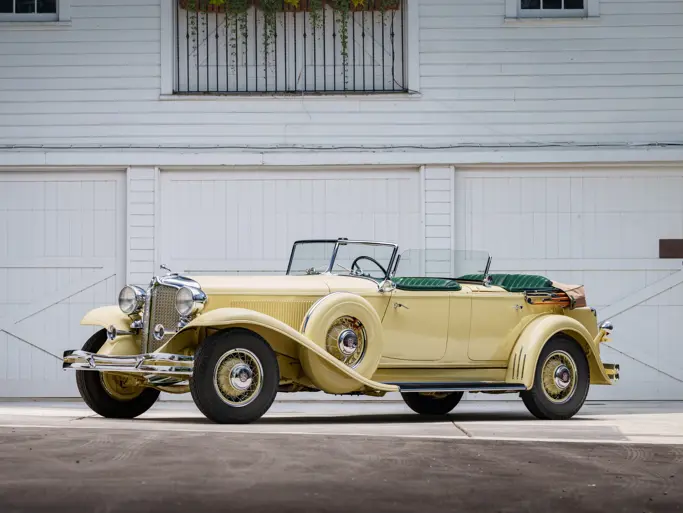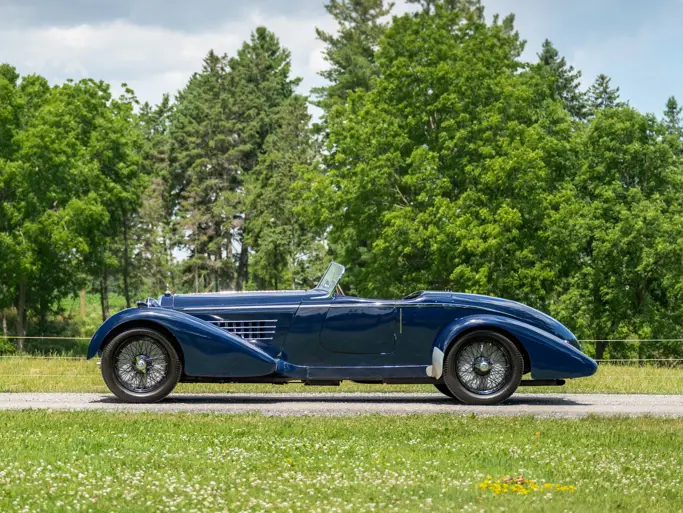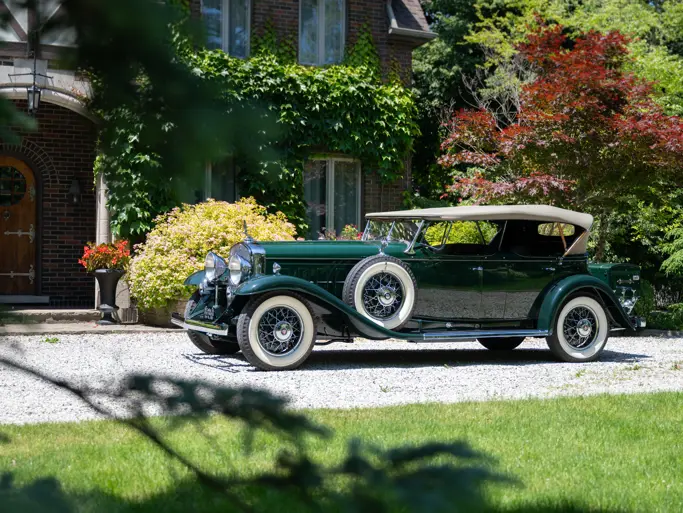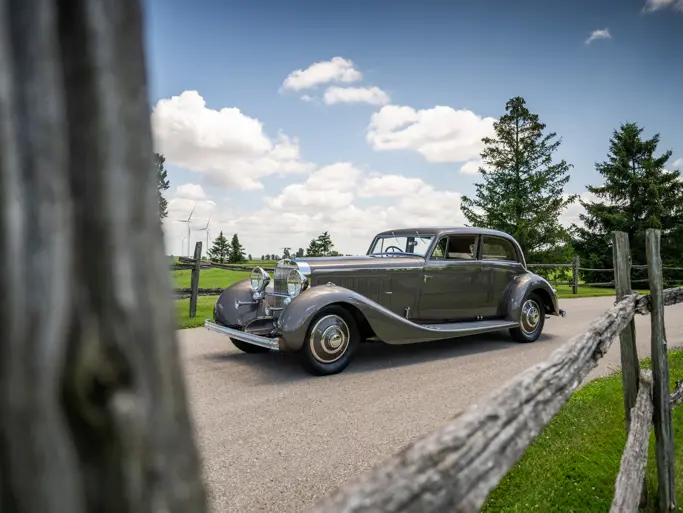Auburn Fall 2012
1935 Duesenberg Model J
Formerly the property of noted collector D. Cameron Peck
{{lr.item.text}}
$456,500 USD | Sold
 | Auburn, Indiana
| Auburn, Indiana
{{internetCurrentBid}}
{{internetTimeLeft}}

The Model J Duesenberg is long regarded as the outstanding example of design and engineering of the classic era. Introduced in 1929, trading was halted on the New York Stock exchange for the announcement. Offered at $8,500 for the chassis alone, it was by far the most expensive car in America. With coachwork, the delivered price of many Duesenbergs cost as much as $20,000; a staggering sum at a time when a typical new family car cost around $500.
Few would argue that the car's features did not support its price. Indeed, the Model J specifications sound current today: 420 cubic inch displacement, 265 horsepower, double overhead-camshafts, four valves-per-cylinder, vacuum-assisted four-wheel hydraulic brakes and eventually, an optional supercharger – all backed by a successful racing history. The new Duesenberg had the power and size to carry impressive coachwork, along with the style and grace of the factory sheet metal design being ideally suited for the execution of elegant custom coachwork. One of the better known firms of the era was Derham Body Company of Rosemount, Pennsylvania. Like many coachbuilders, Derham earned its reputation catering to the carriage trade – those wealthy Philadelphia customers who could afford to commission a specially designed carriage in which to travel, and be seen, in the fashionable areas of town. With the advent of the automobile, Derham’s clientele naturally looked to them to provide the same elegant and luxurious bodies for their motor cars. Primarily known for their formal bodies, town cars and limousines, Derham cars had a reputation for exceptional quality.
One owner who certainly seemed to agree was Mr. O. W. Hunke of Chicago, IL, who bought one of the first Duesenbergs delivered – a Derham-bodied sedan mounted on chassis J119/2144. Mr.Hunke kept his car until 1934, when he returned it to the factory to have his beloved Derham body updated and remounted on a new chassis. The result was J551/2577, a supercharged car with a remarkable and much-modernized body and appearance. In fact, the story of this car is a remarkable testimonial to the determination of Duesenberg to cater to the whims of their wealthy clientele.
The origin of Mr. Hunke’s updated car came in 1934 when Duesenberg realized that it would be necessary to modernize the appearance of the legendary Model J if it was to continue to compete with the latest products from Cadillac, Packard, and others. The main problem was thought to be styling. While the trademark Duesenberg tombstone chrome grille, shutters and long sweeping fenders were the height of style in 1929, by the mid-thirties, they looked dated to many. As a result, a new car was commissioned using a leftover Judkins body from 1929. One of the significant new additions to the coachwork was a dramatic new waterfall-style grille and contemporary skirted fenders. In addition, sleek new bullet-shaped headlights and taillights replaced the large round chrome originals. Additionally, the standard Duesenberg bumper design gave way for single-blade bumpers borrowed from the 1932 Buick. The effect was quite remarkable and seemed to appeal to all who saw it, except for the buyer. Ironically, the purchaser of this newly restyled Duesenberg promptly announced that he wouldn’t take it unless it had the more traditional Duesenberg styling. Off came the new grille, fenders, bumpers and lights. The original style parts were refitted.
Fortunately, the new parts were retained, and when Mr. Hunke came along wanting an updated Duesenberg, he pronounced the new look perfect for his new car. The ever-accommodating Duesenberg Company complied, mounting his old body on the new chassis, removing the dated pieces and installing the ones removed from the Judkins sedan. At the same time, Mr. Hunke ordered the windshield raked back, and a flashy new vee-windshield installed. A flush mounted integral trunk was fit and several other updates made, including the installation of a vent window (on the driver’s side only) so Mr. Hunke could enjoy a fine cigar without too much inconvenience to his passengers.
Little is known of the history of J-551/2577 in the 1940s. Presumably Mr. Hunke used it for some period of time until by the late 1940s, it passed into the hands of well-known dealer John Troka who sold it to early collector Mr. D. Cameron Peck. In 1951, Peck sold the car to West Virginia collector Melvin Clemens. Sometime later, probably in the late 1950s, Clemens sold the Derham sedan to Jack Irwin, who was restoring another car. He removed the body and all the updated sheet metal and set it aside, using the chassis for another project.
Chassis J-310/2144 was purchased new by Chicago businessman Chris T. Weiland and bodied at his request with a Judkins Limousine. After its useful life by Weiland, the car made its way into the hands of John Troka and several other Chicago area collectors before also ending up in the hands of D. Cameron Peck. Peck removed the Judkins body from J-310/2144, setting the chassis aside for some as yet to be determined future project and using the body parts for various other projects.
The parts from the two cars were finally made whole again by none other than legendary Duesenberg collector Homer Fitterling, who purchased the Derham body from Irwin and J-310/2144 from Peck. He restored the chassis and mounted the body, including all of its unique styling features, and allowed the legacy of the unique car to live on. In 1989 collector Ed Weaver of Dalton, GA purchased the entire Fitterling collection, which still retained the Hunke Derham sedan. During his ownership, the car was awarded a Level One Certification as an original car by the Auburn Cord Duesenberg Club. With Weaver's death in the early 1990s, J-310/2144 was acquired by Pennsylvania collector Dr. Joseph Murphy. A year or so later, Murphy traded the car to Houston collector Jerry J. Moore. Moore sold the car by the late 1990s to a gentleman who commissioned a repaint, new interior and thorough mechanical freshening from Duesenberg specialist Brian Joseph of Troy, Michigan. The work performed by Joseph went so far as to include refurbishment of the brakes, wheels, wheel bearings, kingpins, exhaust and other minutiae. At this time the correct Buick style bumpers were located and fitted, fully returning the car to its "as-delivered" appearance in 1935.
Since being acquired by its most recent owner in the early 2000s, J-310/2144 has been on display in the Owl's Head Transportation Museum in Maine, which has afforded two distinct advantages to its next caretaker. Though on static display, the Duesenberg has been exercised regularly and is reported to have fired up and driven with ease when brought out for photography. This limited use has preserved the cosmetic integrity of the restoration while maintaining the soundness of the mechanical refurbishment. Additionally, it has not been campaigned on any classic car tours or at any concours events for most of the last decade and will be a fresh, welcome entrant at virtually any event around the country or the world.
The Hunke Derham sedan is one of just a small handful of Model J Duesenbergs retaining the updated styling features. Besides belonging to a small subset of the exclusive marque, this one-off design has many bespoke elements, and it would not be inappropriate to liken the waterfall grille to the design employed on the famous Mormon Meteor. Aside from unique design, it is very well-documented and has been the feature car in numerous articles including the January – February 2000 edition of the Michigan Region Classic Car Club of America publication "Torque", in which Mr. Joseph mentions that this example also features a unique gas tank extension, something he had seen only once before. In that issue, images of the car in its original delivery configuration can be seen as well. This closed Duesenberg can also be seen in Dennis Adler's book "Duesenberg" and on page seven of Fred Roe's venerable reference, "Duesenberg: The Pursuit of Perfection." With unique characteristics, well-documented history, as well as a list of owners that reads like a "Who's Who" of collectors; the Hunke Derham Sedan is a truly special car and will continue to stand as a testament to the service and exclusivity offered by one of America's most fabled automobile manufacturers.





